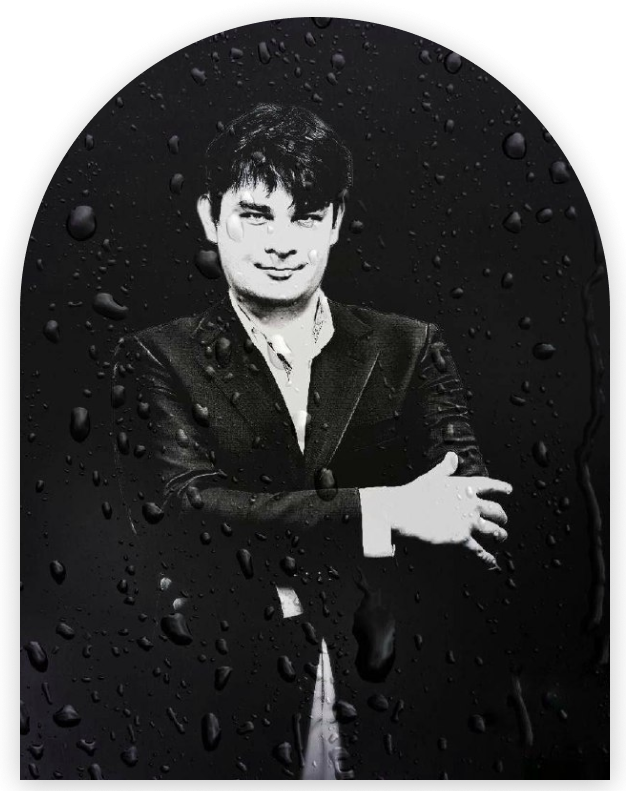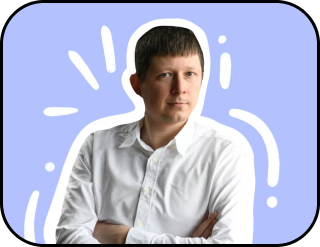“A person who can understand quantum mechanics, the theory of relativity, and chaos theory will inevitably become their true self.”
A confession of the candidate of Physical and Mathematical Sciences and PhD in Mathematics from the University of Missouri
Valerian Yurov.
Adding the word ‘quantum’ to any concept immediately elevates it to a fundamentally impressive and simultaneously fundamentally mysterious status. The secrets of the universe hidden from humans by quantum physics and why it is impossible to negotiate with dark matter were topics discussed with the editors of The Global Technology magazine by Valerian Yurov, a candidate of Physical and Mathematical Sciences, PhD in Mathematics from the University of Missouri, author of numerous publications on classical and quantum cosmology, hydrodynamics, mathematical physics, magnetism, and mathematical modeling of mtDNA mutagenesis.

— Valerian, for many people, quantum physics is not very understandable. Could you please explain how quantum physics is connected to our daily lives? Perhaps we use it every day without even knowing it.

— Excellent question. There is a kind of little secret known to every theoretical physicist but which goes unnoticed by most laypeople. It lies in the fact that if there were no quantum mechanics, there would be no us. There would be no life, no planets, no matter as we know it. Take us, for example. We are made of various cells. And what are cells made from? Cells are made from proteins, which in turn are made from amino acids – long molecules composed of atoms. Essentially, our entire structure depends on how these atoms interact with each other.
What does ‘interact’ mean? What is all chemistry based upon? Chemistry determines things like the hardness of our bones or the elasticity of our skin, or even the existence of enzymes that help us digest food. All of this is based on chemistry. And fundamentally, chemistry is just interactions of electrons within atoms. It’s these interactions, how electrons overlap and influence each other, and how many electrons there are – whether they are easily detached or not – that forms the basis of our entire existence, all of our life.
You and I know that an atom is considered indivisible. It consists of electrons and what’s called an atomic nucleus. Electrons are not just any particles or spheres; they are particles that carry an electric charge. They are negatively charged. However, if we take any random atom that isn’t ionized and exists in a normal state, and look at it from a distance, we will see that there is no electric field around the atom, despite it containing an electron. Since there is no electric field around the atom, this means that the negative charge is compensated for by something. It’s compensated by the atomic nucleus, right?
So the question arises: how does the electron move around the nucleus?

— And how does the electron move?

— For instance, an electron could just hover above the nucleus.
But that’s a bad scenario because the electron and the nucleus are charged differently – one positively, the other negatively. If you leave the electron alone, it will fall onto the nucleus and that’s it. The electron would cease to exist. It’s the same reason that if you drop a stone, it will just fall to the planet’s surface. Therefore, electrons cannot simply hover above nuclei.
For the same reason, electrons cannot move at a constant speed relative to the nucleus: first, because the attractive force would constantly bend their trajectory; and second, if an electron were to fly straight, it would just fly out of the nucleus, and the atom would cease to exist. Thus, the electron must somehow orbit around the nucleus!
The problem is that this can’t happen either. It’s impossible for the Moon to orbit our planet or for Earth to orbit the Sun from the perspective of classical physics. An electron cannot orbit a nucleus because if you orbit around an object, it implies you are experiencing acceleration. You aren’t moving at a constant speed; you are accelerating.
This is an important fact derived from Maxwell’s equations: any particle moving with acceleration, that rascal, emits light. If you were to take an electron, for example, with an electronic tweezer and start wiggling it, it wouldn’t just move from side to side; as it moves, it would also start emitting light.
Almost all emitting devices are built on this principle. For instance, the tools providing us with Wi-Fi, Bluetooth, and satellite signals. If you dismantle them and look closely at what emits there, you’ll see a tiny wire where electrons rush back and forth under the influence of an external electric field.
Do you understand? Everything’s fine with the emitter. We supply energy to the electrons ourselves, which they use to emit light. Radio waves, Bluetooth, and so on. But in an atom, the electron has nowhere to get additional energy from. If it were moving with acceleration, firstly, it would start emitting light, but atoms in their free state don’t emit anything.
Normal atoms emit nothing in their normal state. Furthermore, even if the electron were emitting, it would mean it’s simply losing energy, with no one replenishing it. It’s not on anyone’s payroll!
So, losing energy, it would simply lose speed. Losing speed, it would eventually stop rotating and, like a stone, fall onto the nucleus and vanish.
Why am I telling you this? If quantum mechanics didn’t exist, if the behavior of all particles, including elementary ones, adhered only to classical mechanics – the one diligently taught in schools – there would be no atoms, hence no molecules, no amino acids, proteins, cells, and consequently, no us. There would be no matter, at least not in the sense we understand it. Thanks to quantum mechanics, we exist, and for that, we can be grateful.
Therefore, when we ask, ‘Why do we need quantum mechanics?’ Well, quantum mechanics gave us lasers, quantum computers, superconductors, and various semiconductors, all based on quantum behavior. Most importantly, we exist solely because quantum mechanics is true, while classical mechanics is not. A big thank you to quantum mechanics! This is the most important secret – there would be no us without quantum mechanics.

— There’s a claim that ‘quantum’ physicists are like the masons of the scientific world. Who are these ‘quantum’ physicists?

— They are people who are genuinely hard to impress. That’s why, by the way, many physicists enjoy reading science fiction. It’s because sometimes you want to take a break from those insane formulas, the madness happening on macro and micro scales, from universes collapsing into points, or black holes emitting and exploding. Sometimes you want something familiar, cozy, uncomplicated. Some galactic empires, blasters, aliens.

— Why is quantum physics still so difficult for many? Even educational programs don’t give it enough attention?

— Quantum physics is difficult because you have to learn to completely discard what was considered unshakable. Because you need to change your worldview, and that’s very difficult, changing your worldview. It’s one of the most challenging things. One of the most challenging things is to discard something you like. Some concept, some belief. To look at something, in human terms, from a different perspective.
Now we’ll set up an experiment to demonstrate that an electron passes simultaneously through two slits in a screen. How can we understand this from our ordinary everyday perspectives? We can’t! We just need to discard what we know. We need to understand that they are simply wrong because there’s a certain generalization that only works on a micro scale. And just because something works on a micro scale, these small quantum uncertainties are swallowed up by us, and on large scales, they simply blur out. But they exist! That’s the thing!
Understanding all of this turns people into individuals who can engage in absolutely everything. A theoretical physicist like me, for example, can engage in cosmology with the consideration of quantum mechanics. I used to work in hydrodynamics. Quite recently, and unexpectedly even for myself, I even started working in biology. Colleagues in biology asked me, as a good mathematician, to construct a mathematical model for them of how mutagenesis occurs in mitochondrial DNA. I made them such a model.
Where am I leading with all this? A person who can understand how quantum mechanics works, as well as the theory of relativity and chaos theory, is someone who is no longer afraid of anything. They can engage in absolutely everything.
Moreover, they are people who are ready to discard any hypothesis, even the most beloved one, just because they’ve been shown how deeply ingrained beliefs about how the world works, and how classical physics works, are incorrect and how people, much more experienced than you, had to get rid of them and replace them with something much more viable, back in the early 20th century.
This characteristic distinguishes professional physicists and professional scientists from physicists and most people.

— Quantum physicists like to break patterns, but sometimes these same patterns break them.

— Physicists are always prepared for the fact that what they measure is not true. But what else can they do? They’ve already learned about life. They’ve already learned about the flow of physics, and what they considered absolutely fair may be fair, but not always. And even what’s been repeatedly proven may be a tiny piece of the complete truth of what’s really happening.

— In quantum physics, is there such a thing as ‘time’?

— Do you know how time arises in quantum physics? It arises when there’s an observer. And it’s a very amusing situation. From the perspective of the entire universe, there’s no time at all. But from the perspective of a part of this universe, say, the observer, time exists. It flows. But for the entire universe, there isn’t any. It’s an interesting situation like that.

— As far as we know, the author of the theory of relativity did not accept quantum theory. Why did Einstein disagree with quantum theory?

— It’s a very interesting situation that led to interesting results. Einstein didn’t like quantum mechanics very much. He didn’t like the fact that, unlike classical physics and even the theory of relativity he developed, quantum mechanics relies on probability, that all processes involving elementary particles and everything that happens on a micro scale are governed by laws that are strictly probabilistic. For example, where an electron will end up if you fire it from an electron gun? What will happen to the electron if you want to measure its spin? All of these are purely probabilistic processes. This aspect didn’t sit well with Einstein.
One of Einstein’s most vexing issues with quantum mechanics was the so-called Heisenberg Uncertainty Principle, for understandable reasons. Without delving into mathematical details, this principle suggests that if you can’t measure something, it doesn’t exist. Agreeably, it even sounds like sheer nonsense.
So, Einstein, along with a few like-minded colleagues, Rosen and Podolsky, began searching for examples where, at least theoretically, the uncertainty principle could be violated. They pondered whether they could devise a thought experiment that would demonstrate the absurdity of the axioms on which quantum mechanics is based. Together, they conceived an experiment that stirred excitement among physicists.
Imagine, said Einstein, we have a particle or an atom. Suppose this particle decays into two identical particles. Now, envision these two particles flying apart, one to the left, the other to the right. We’ll wait for a while until one of them flies very, very far to the opposite side of our solar system. Then, an experimenter catches the first particle and measures its coordinate to demonstrate that the coordinates of the split particles are connected, even across a distance.
So, the experiment showed that such a pair of particles is indeed entangled with each other. As soon as you change the coordinate of the first particle, the second particle also feels it, and its momentum starts to spread out. You can say something about the momentum of one particle, but nothing can be said about the momentum of the other. This proof precisely indicates that quantum mechanics is correct!
Entangled particles that sense the state of the other particle – their partner – across arbitrarily large distances. A particle can fly, even to the edge of the solar system, to the opposite side of the entire observable universe, but it will still sense the first particle. Moreover, it will sense the first particle immediately and instantly feel it if experiments or simply measurements are conducted on the first particle.
You can call it whatever you want, magic, EPR experiment, mischief. I, however, prefer the word – love.

— Valerian, what is a ‘miracle’ from the perspective of quantum physics?

— How about this example of a miracle? If we consider any real physical processes involving many molecules, for example, the same air molecules, there will always be very unlikely but physically possible pieces of a wave function that would describe any arbitrarily unlikely event. For example, the existence of something like Hogwarts, where, by waving a wand, you could, for instance, summon fire or make a feather on the table levitate.

— Is that possible?

— It’s possible. It’s just that the probability of it is very low. But such a world definitely exists somewhere. However, we won’t find ourselves in it because, like not very skilled travellers, after each measurement, we end up on the branch that is the most probable. We could end up on a less probable one, similar to, say, drawing a specific card from a deck of cards. There’s a chance we might draw, for instance, the queen of spades. But this probability is lower than the probability of drawing a six or a seven because there are more of those cards in the deck. But such a probability exists.
If we had some kind of machine, like in the movie ‘Everything, Everywhere, All at Once,’ that allowed us to travel across Everett’s worlds, and we could choose the worlds we wanted to visit, then we could see very strange and unusual things. We don’t see them only because we end up in more probable, modest, boring, classical worlds.

— We can’t help but ask about quantum physics and artificial intelligence. Let’s speculate on the future of artificial intelligence in the world of quantum physics.

— Damn if I know what could come out of this. It’s a hypothetical question because, for now, we don’t know how to create either living beings or even artificial intelligence. All we have are neural networks. That’s not artificial intelligence.
Neural networks, including the famous ChatGPT or MidJorni, all these wonderful and heavily advertised systems, are often called artificial intelligence, and huge sums of money are allocated for the development of artificial intelligence. They are simply large linguistic systems or large language systems. The problem is that, firstly, this technology is not new. More precisely, as a technology existing in hardware, it is new. But the idea goes back to the 1970s when the concept of large language programs was first invented. And everything they can do was already thought up by the fathers and founders from a mathematical point of view. It’s just that now, finally, the technology has reached the point where we can create prototypes and working models of these language systems based on these mathematical developments. Besides, we have Google, for example, which has digitized a huge number of books that can be used to train these systems. We didn’t have that before. But the difference with what we call artificial intelligence here is fundamental.
Neural networks can only help you do what you can already do yourself. But if you try to create something for which there are no analogs in the system, the system starts hallucinating because it has nothing to draw from. The neural network tries to pick the points that are closer. There’s nothing closer. Then it takes those that are farther away. They turn out to be so far away that the recipe turns into something like ‘take a rubber boot and cook it with crickets.’
This is, of course, a very rough description, but that’s roughly how it turns out. One example was in 2020 or 2021 when Facebook launched a system, I think it was called Galactica, which was supposed to help scientists compile summaries and digests from scientific articles. It all ended in disaster.

— If we assume that artificial intelligence will still be created, what then?

— Let’s remember the scientific work published in MIT, where scientists recorded the so-called ‘second sound’ phenomenon in a supercooled cloud of Fleit atoms. If you have a very, very cooled substance, for example, helium-2 atoms or lithium atoms, in the experiment described by the scientists, you get a very interesting effect – the temperature begins to propagate in waves, like sound. Roughly speaking, by heating the cloud of atoms, you make it sound. But we won’t hear this sound because our ears are not accustomed to listening to changes in temperature.
Maybe we could construct some kind of artificial intelligence with two pairs of ears, like ours, which would hear the propagation of various pressure waves and heat waves, thus paving the way for a new kind of living beings. Why not? Imagine how we could then converse simultaneously, using two different types of sound? After all, all the best things in this world were invented by physicists.

We illuminate scientific horizons with an intensity that rivals a laser.
Thank you!




